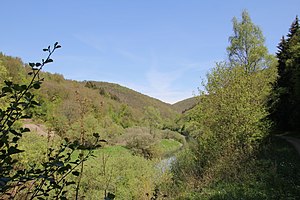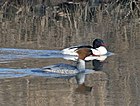Kermeter-Hetzinger Forest
|
EU bird sanctuary
"Kermeter-Hetzinger Wald" |
||
|
At the Urftsee |
||
| location | City region Aachen , Düren district and Euskirchen district , North Rhine-Westphalia , Germany | |
| Identifier | DE-5304-402 | |
| WDPA ID | 555577678 | |
| Natura 2000 ID | DE-5304-402 | |
| Bird sanctuary | 47.711 km² | |
| Geographical location | 50 ° 37 ' N , 6 ° 27' E | |
|
|
||
| Setup date | 2011 | |
| administration | Regional Council Cologne | |
| particularities | three sub-areas | |
The Kermeter-Hetzinger Wald area is a European bird sanctuary (protected area identifier DE-5304-402) in the southwest of the German state of North Rhine-Westphalia, which was designated by ordinance of 2011 by the Cologne Regional Council .
The Birds Directive of the European Union serves to preserve the wild bird species native to the territory of its member states and to regulate the protection, management and regulation of these birds, their eggs and habitats .
location
The three sub-areas of a total of about 48 square kilometers bird sanctuary "Kermeter-Hetzinger Forest" are in the Aachen region and the districts Düren and Euskirchen . They stretch along the Rur and Urft lakes , between Nideggen in the north-east, the Herhahn district , which belongs to the town of Schleiden, in the south, and the Rur dam in the west.
description
The protected area "Kermeter-Hetzinger Wald" is defined as an area with "large-scale grove and woodruff beech forests, ravine forests, silicate rock areas, deciduous oak and hornbeam forests, near-natural flowing waters, the stream-accompanying alder and ash forests, Coniferous forest and small grassland areas with hay meadows ”.
The mixed deciduous forests accommodate almost the entire spectrum of bird species for the natural area and other FFH- relevant species such as the wall lizard and the wildcat . The occurrence of the middle woodpecker determines the value of the bird sanctuary . Furthermore, the gray and black woodpecker , red and black kite , eagle owl and wasp buzzard are represented as breeding bird species that are important in terms of their natural habitat. Regular Food guest is the black stork , osprey are during the course especially in the Urfttalsperre observed.
Habitat classes
| N06 - inland waters, standing and flowing | 5% | |||
| N10 - Moist and mesophilic grassland | 5% | |||
| N16 - deciduous forest | 60% | |||
| N20 - artificial forests | 29% | |||
| N22 - inland rocks, scree and rubble heaps, sandy areas | 1 % | |||
Protection purpose
The main protection purpose is the preservation and promotion of large-scale deciduous forest stands from local species, in which forest use has been completely discontinued since 2003. In addition, stands of non-indigenous tree species ( Douglas fir ) are to be transferred to deciduous forest stands of potential natural vegetation.
The area-related conservation objectives and conservation measures are described differently depending on the species .
Breeding birds
kingfisher

Preservation and development of dynamic river systems with flood zones, impact slopes, steep banks, the avoidance of the fragmentation of the populated habitats, the preservation and promotion of a permanent offer of natural nesting places, the careful water maintenance taking into account the demands of the species, the reduction of nutrients, pollutants and Sediment input in the area of the food waters as well as the avoidance of disturbances at the breeding sites from March to September
Gray woodpecker
Preservation and development of extensive, habitat-typical deciduous and mixed forests (especially beech forests) with high proportions of old and dead wood of up to ten trees per hectare, avoidance of fragmentation and islanding of populated forest areas, preservation and development of sunny clearings, forest edges, light forest structures and small structures (stumps, dead wood) as well as grassland as food areas, the improvement of the food supply (e.g. reduced fertilization, no pesticides), the maintenance of cave trees and the requirement for a permanent supply of suitable breeding trees (especially> 100-year-old beeches, trees with Damaged areas) as well as the avoidance of disturbances at the breeding sites from March to July
Middle woodpecker
Preservation and development of extensive, habitat-typical deciduous and mixed forests as well as hardwood meadows with high proportions of old and dead wood, increasing the proportion of oak forests, avoiding the fragmentation and islanding of suitable forest areas, improving the food supply, maintaining cave trees and promoting a permanent supply of suitable ones Breeding trees as well as avoiding disturbance to the breeding grounds from March to June
Red backs
Preservation and development of extensively used semi-open, bushy cultivated landscapes with insect-rich food areas, the prevention of succession through de-bushing and care, the improvement of agricultural habitats by extensification of grassland use (reduced fertilization, no pesticides, extensive grazing with sheep, cattle) and the avoidance of Disturbances in the breeding grounds from May to July
Red kite
Preservation and development of forest areas with sparse old wood stocks as well as open, structurally rich cultural landscapes, the avoidance of fragmentation and islanding of populated habitats, the preservation and development of suitable food areas (especially grassland and arable land, fringes, leaving stubble fallow), the preservation of Horst trees with a low-disturbance environment, the avoidance of disturbances at the breeding grounds from April to July, the defusing or protection of dangerous electricity pylons and overhead lines as well as the reduction of losses due to secondary poisoning (poison bait)
Black kite
Preservation and development of old, structurally rich deciduous and mixed forests in the vicinity of water bodies with a high proportion of old wood and tree species typical of the habitat, the preservation and development of near-natural, fish-rich food waters, the improvement of the food supply (no pesticides), the preservation of eyrie trees with a low-disturbance environment, the Avoidance of disruptions at the breeding sites (April to July) as well as the defusing or protection of dangerous electricity pylons and overhead lines
Black woodpecker
Preservation and development of habitat-typical deciduous and mixed forests (especially beech forests) with high proportions of old and dead wood (up to ten trees per hectare), the avoidance of the fragmentation of the populated forest areas, the preservation and development of sunny clearings, forest edges, light forest structures and Small structures (stumps, dead wood) as food areas, the improvement of the food supply, the maintenance of cave trees and the promotion of a permanent supply of suitable breeding trees (especially> 120-year-old beeches) and the avoidance of disturbances in the breeding grounds from March to June
Black stork
Preservation and development of large-scale, poorly disturbed, structurally rich deciduous and mixed forests with a high proportion of old wood, the avoidance of the fragmentation of suitable forest areas, the preservation and development of near-natural streams, wet meadows, wet areas, swamps, forest ponds as food areas (defrosting of the brook meadows, new creation of wet areas , Keeping forest meadows open), the improvement of the water balance to stabilize a high groundwater level in the area of food waters, the avoidance of disturbances in the breeding grounds and food areas from March to August, the control of recreational use in the large area around the breeding occurrence as well as defusing or safeguarding dangerous Electricity pylons and overhead lines
Eagle owl
Preservation of undisturbed rocks, ledges and rocky knolls, avoiding backfilling and / or afforestation of abandoned quarries, avoiding the fragmentation of populated habitats through, for example, road construction, possibly careful clearing of growing breeding sites, avoiding disturbances at the breeding sites in February until August (including steering of recreational use such as climbing, motocross) as well as defusing or protecting dangerous electricity pylons and overhead lines
Honey buzzard
Preservation and development of deciduous and mixed deciduous forests with sparse old wood stocks in structurally rich, semi-open cultivated landscapes, the preservation and development of clearings and grassland areas, structurally rich forest edges and fringes as food areas with a rich supply of wasps, the improvement of the food supply, the preservation of the eyrie trees with one low-disturbance environment as well as avoiding disturbances at the breeding grounds from May to August
Migratory birds and winter guests
Osprey
No special measures are currently required (as of 2020)
Goosander
Preservation and development of suitable feeding waters as well as the avoidance of disturbances at resting, feeding and sleeping places
Gray shrike
Preservation and development of extensively used semi-open cultivated landscapes with suitable food areas, the prevention of succession through de-bushing and care, the improvement of agricultural habitats through the extensification of land use (e.g. reduced fertilization, no pesticides, extensive grazing with sheep, cattle) and the avoidance of Disturbances in the breeding grounds from April to July
Wood sandpiper
Preservation and development of suitable foraging areas, the preservation and development of dynamic floodplain areas and large-scale wetlands with near-natural flooding dynamics, the improvement of the water balance to stabilize a high groundwater level in wetlands, the creation of small bodies of water and shallow water hollows as well as the avoidance of disturbances in resting and foraging areas
Connection with other protected areas
With the bird sanctuary "Kermeter-Hetzinger Wald" the following, related protected areas (list not complete) are designated:
- Eifel National Park
- FFH area " Kermeter " (5404-301)
- " Kermeter " nature reserve (EU-041)
- Nature reserve " Meisberg north of Mauel " (EU-042)
See also
Web links
- The protected area at www.protectedplanet.net
- The protected area at the Federal Agency for Nature Conservation
- The protected area at the State Office for Nature, Environment and Consumer Protection in North Rhine-Westphalia
Individual evidence
- ↑ Article 1 of the current Birds Directive
- ↑ Map of the protected area at www.protectedplanet.net, accessed on May 5, 2020.
- ↑ Description of the bird sanctuary at the State Office for Nature, Environment and Consumer Protection North Rhine-Westphalia , accessed on May 11, 2020.







